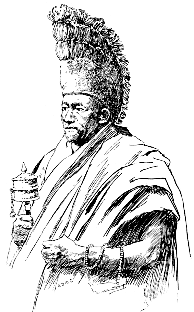Athena Review Image Archive ™
Tibet: K'an-po or abbot of a Buddhist monastery (1895 drawing)

Tibet: K'an-po or abbot of a Buddhist monastery (Waddell 1895)
Tibetan Buddhism or Lamaism evolved from the Mahayana Buddhism brought by missionaries from India during the early 7th century AD. By 765, the earliest Tibetan monastery was founded at Samye during the regin of King Trisong Detsen.
In
AD 1040 a reform movement was initiated by the arrival of Atisa (AD
982-1054) a great Buddhist scholar from Bengal, India, invited by the
king of Guge in western Tibet. Over the next centuries, a number of
sects emerged. Since the 17th century, the predominant sect has been
the Gelugpa, commonly known as the Yellow Hats, which includes the
order of the Dalai Lama, political and spiritual ruler of Tibet, and
the Panchen Lama, a main spiritual authority.
Leading
several grades of Tibetan monks was the K'an-po or abbot, head of a
monastery. Many religious institutions were destroyed during the
"Cultural Revolution" of the 1960s and `70s. In the 1980's, some
monasteries were allowed to re-open and recruit new monks. Today,
however, Tibet has far fewer monasteries, which nevertheless remain
centers of education, art, and public worship.
This drawing of a Buddhist abbot or k'an-po is from Waddell (1895).
.Copyright © 1996-2019 Rust Family Foundation (All Rights Reserved).